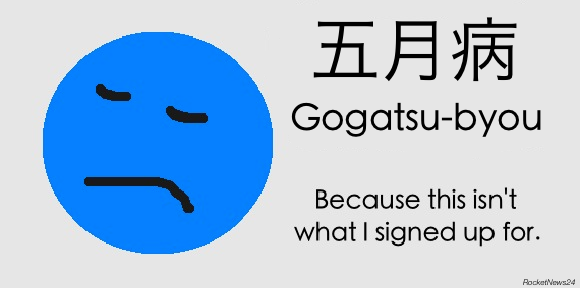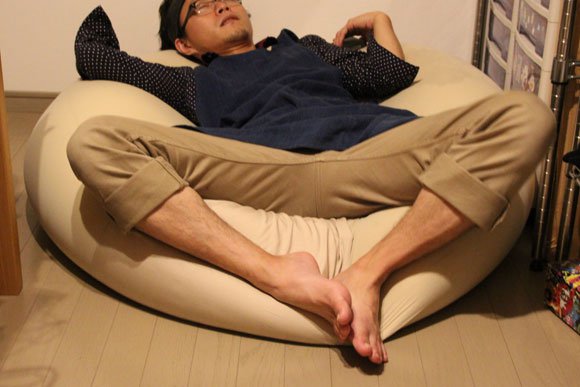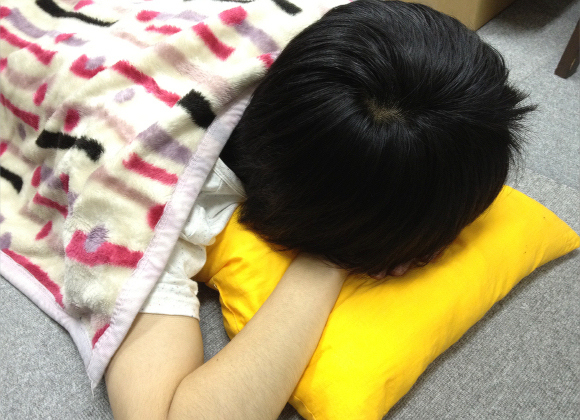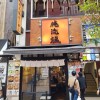
As well as being the start of the new business and academic year, April in Japan also marks the time when new graduates make their first forays into the world of full-time employment and many companies rotate their staff both to keep them on their toes and help them acquire new skills. It’s a fun, frenetic time of year, and everyone from kids in their new school uniforms to fresh-faced employees wearing crisp, black suits looks tremendously smart and presentable as they hurry to their place of education or employment, eager to make the most of their day.
In May, however, it all comes crashing down. Reality sets in and people start to realise that everything is just as awful as it was before, albeit with a few quirks and a shiny new name badge or lunchbox. The fire in kids’ bellies goes out, the twinkle disappears from new employees’ eyes, and they start to approach their work with all the enthusiasm of a pot-smoking snail going through a serious emo phase.
This, dear reader, is gogatsu-byou; the phenomenon that occurs every May and affects millions of Japanese to some degree or other.
If you managed to summon the energy to click on this post and are reading these words, then give yourself a big pat on the back. You’re either one of the few who isn’t suffering with early-onset gogatsu-byou – literally “May sickness” – or you’re what people living outside of the UK think we British would call “a bloody trooper.”
Fans of manga and anime may well have heard of chuuni-byou (中二病), literally meaning “middle-two sickness”, from the popular light novel and anime series Love, Chunibyo & Other Delusions. Chuuni-byou is a term that is often used in Japanese junior high schools to describe the change in the attitudes of students as they pass from the first to the second grade. Once spritely little tykes with high-pitched voices and all the enthusiasm in the world, by the time they’ve reached the second grade, the same kids often become moody, lethargic, and generally too-cool-for-school, even if part of them is secretly the same fun-loving kid they always used to be.
Despite both containing the kanji character for sickness (病), neither chuuni-byou nor gogatsu-byou are actual medical conditions, so seeking help with either of them would be like going to your doctor with a minor case of the grumpies or can’t-be-arsed-ivitus.
Nevertheless, at this time of year the May blues are frequently referred to all over Japan, and the syndrome is often taken surprisingly seriously.
Gogatsu-byou becomes a bigger problem around the start of the second week of May. As you may know, Japan has no fewer than four public holidays in the first week of May, collectively known as Golden Week, prompting millions to take trips, visit relatives, go shopping, or just kick back and relax. Although nothing like the mass exodus seen during Chinese New Year, Japan is a hive of movement and activity at this time of year, and the holidays come as a huge boon to the economy, with hoteliers, restauranteurs, and store owners traditionally spending months gearing up for these public holidays since they would make so much money (or ‘gold’, hence the name) in such a short space of time, sometimes even relying on Golden Week to get them through the financial year.
For everyone else, though, Golden Week is all about having fun and taking it easy. So when this extended period of lethargic bliss suddenly comes to an end, you can bet that there are a few casualties, and it’s usually the newbies – most notably the young graduates who just started at university or began working for the first time in April – whom it hits the hardest.

Japan’s May blues can be characterised by anything from a general lack of energy to feeling completely dissatisfied with one’s lot in life. Just as how children in the West struggle to get back into a regular routine or carry out the tasks they did prior to the holidays (who among us didn’t “forget” how to write after the long summer break?), school kids in Japan are known to struggle to pay attention following the Golden Week break. Universities, too, often see a marked drop in attendance following the holidays as new students – the thrill of being accepted into their institution of choice, finding their way around the campus and making new friends having worn off – struggle to get out of bed each morning, and start skipping lectures.
Most people get over it within a couple of days and begrudgingly drag themselves to school or work, but in the rarest of cases, gogatsu-byou can become a serious problem.
For those starting out at a new company, the time off in May – after barely a month in their new role – allows them time to reflect. It is only then that all the things they previously longed for or saw as marks of success – putting on a suit; taking the train during rush hour; exchanging business cards with clients and coworkers – suddenly start to seem far less glamorous, and the monotony of working life becomes clear.
Perhaps more troubling than that, though, is the sudden realisation by many new employees that this, their new life and working situation, is ‘it’. Add in the fact that, since most Japanese still consider it standard practice to remain at the same company for one’s entire working lifetime (changing careers is often looked on as a sign of indecision or weakness), many new recruits suddenly panic and feel that they have lost all control.

For this reason, as well as seeing an increase in the number of sick-days taken by employees both old and new, it is not unheard of for companies to lose newer members of staff during the month of May. The combination of a break so soon after starting work for the first time and the realisation that full-time employment isn’t quite the reward that they’d hoped for when sitting university exams, sending out hundreds of resumes and attending dozens of interviews can hit some people hard, sometimes even causing them to rethink their lives and, in rare cases, hand in their notice.
Thankfully, the vast majority of people manage to shake the May blues off after just a few days and come to realise that, compared to walking miles every day just to fetch a few gallons of clean drinking water or having to be carried across a rapidly flowing river in a plastic bag to get to school, being a bit down in the dumps because the holidays are over probably isn’t the worst deal ever. The temptation to take a sickie will be probably felt more strongly after Golden Week than at any other point in the year for most Japanese, but thankfully most will still suit up and take one for the team.
That being said, if the company you work for happens to have dealings with Japan, you’re an English teacher struggling to motivate a classroom full of Japanese kids, or perhaps you’re simply a reader of a certain Tokyo-based Japan and Asia news site, and you happen notice that things aren’t running quite as smoothly as normal around the second week in May, spare a thought for those of us feeling the effects of gogatsu-byou.
We know we’re supposed to be professional whatever the time of year, but just like how people in the West struggle to find the motivation to head back to work following Christmas and the New Year’s break, most of Japan will be on a major come-down around the second week in May. And after sipping beer in the pleasantly warm spring sun, taking a trip to a hot spring, or spending multiple nights parked in front of the TV watching Game of Thrones until the wee hours of the morning, there’s only one thought going through most people’s minds during the first few days back after Golden Week: Everything is awful and nothing good will ever happen again.
Well, until July 21, when we all get the day off to think about the sea…

 Anything is paw-sible! Pianist holds virtual concert with a rescue dog accompanying him【Video】
Anything is paw-sible! Pianist holds virtual concert with a rescue dog accompanying him【Video】 Japanese government mulling over potential four-day working week
Japanese government mulling over potential four-day working week Japanese new recruit fired after one month for being partially out of frame during video meetings
Japanese new recruit fired after one month for being partially out of frame during video meetings Spend a shift working in a terrible, soul-crushing Japanese company at this “special” Tokyo event
Spend a shift working in a terrible, soul-crushing Japanese company at this “special” Tokyo event Awesome smiling Shiba dog in Japan doesn’t have a job, still seems to know it’s vacation time
Awesome smiling Shiba dog in Japan doesn’t have a job, still seems to know it’s vacation time Japanese ramen restaurants under pressure from new yen banknotes
Japanese ramen restaurants under pressure from new yen banknotes McDonald’s new Happy Meals offer up cute and practical Sanrio lifestyle goods
McDonald’s new Happy Meals offer up cute and practical Sanrio lifestyle goods Sakura tree falls on man at Sannenzaka near Kiyomizu temple in Kyoto 【Breaking News】
Sakura tree falls on man at Sannenzaka near Kiyomizu temple in Kyoto 【Breaking News】 New private rooms on Tokaido Shinkansen change the way we travel from Tokyo to Kyoto
New private rooms on Tokaido Shinkansen change the way we travel from Tokyo to Kyoto We tried Korea’s way-too-big King Tonkatsu Burger at Lotteria 【Taste Test】
We tried Korea’s way-too-big King Tonkatsu Burger at Lotteria 【Taste Test】 Japanese company starts project to restore Nakagin Capsules to capsule hotel
Japanese company starts project to restore Nakagin Capsules to capsule hotel Studio Ghibli releases new action figures featuring Nausicaä of the Valley of the Wind characters
Studio Ghibli releases new action figures featuring Nausicaä of the Valley of the Wind characters Katsudon vs. tonkatsu vs. katsu sandwich – What’s the best way to eat pork cutlet in Japan?
Katsudon vs. tonkatsu vs. katsu sandwich – What’s the best way to eat pork cutlet in Japan? Non-ramen Ramen Restaurant Stars: The quest begins at Tokyo’s Oreryu Shio
Non-ramen Ramen Restaurant Stars: The quest begins at Tokyo’s Oreryu Shio French Fries Bread in Tokyo’s Shibuya becomes a hit on social media
French Fries Bread in Tokyo’s Shibuya becomes a hit on social media All-you-can-drink Starbucks and amazing views part of Tokyo’s new 170 meter-high sky lounge
All-you-can-drink Starbucks and amazing views part of Tokyo’s new 170 meter-high sky lounge More foreign tourists than ever before in history visited Japan last month
More foreign tourists than ever before in history visited Japan last month Starbucks reopens at Shibuya Scramble Crossing with new look and design concept
Starbucks reopens at Shibuya Scramble Crossing with new look and design concept Disney princesses get official manga makeovers for Manga Princess Cafe opening in Tokyo
Disney princesses get official manga makeovers for Manga Princess Cafe opening in Tokyo Beautiful new Final Fantasy T-shirt collection on the way from Uniqlo【Photos】
Beautiful new Final Fantasy T-shirt collection on the way from Uniqlo【Photos】 Is the new Shinkansen Train Desk ticket worth it?
Is the new Shinkansen Train Desk ticket worth it? Studio Ghibli glasses cases let anime characters keep an eye on your spectacles
Studio Ghibli glasses cases let anime characters keep an eye on your spectacles Studio Ghibli releases Kiki’s Delivery Service chocolate cake pouches in Japan
Studio Ghibli releases Kiki’s Delivery Service chocolate cake pouches in Japan New definition of “Japanese whiskey” goes into effect to prevent fakes from fooling overseas buyers
New definition of “Japanese whiskey” goes into effect to prevent fakes from fooling overseas buyers Our Japanese reporter visits Costco in the U.S., finds super American and very Japanese things
Our Japanese reporter visits Costco in the U.S., finds super American and very Japanese things Studio Ghibli unveils Mother’s Day gift set that captures the love in My Neighbour Totoro
Studio Ghibli unveils Mother’s Day gift set that captures the love in My Neighbour Totoro Domino’s Japan now sells…pizza ears?
Domino’s Japan now sells…pizza ears? New Japanese KitKat flavour stars Sanrio characters, including Hello Kitty
New Japanese KitKat flavour stars Sanrio characters, including Hello Kitty New Pokémon cakes let you eat your way through Pikachu and all the Eevee evolutions
New Pokémon cakes let you eat your way through Pikachu and all the Eevee evolutions Sales of Japan’s most convenient train ticket/shopping payment cards suspended indefinitely
Sales of Japan’s most convenient train ticket/shopping payment cards suspended indefinitely Sold-out Studio Ghibli desktop humidifiers are back so Totoro can help you through the dry season
Sold-out Studio Ghibli desktop humidifiers are back so Totoro can help you through the dry season Japanese government to make first change to romanization spelling rules since the 1950s
Japanese government to make first change to romanization spelling rules since the 1950s Ghibli founders Toshio Suzuki and Hayao Miyazaki contribute to Japanese whisky Totoro label design
Ghibli founders Toshio Suzuki and Hayao Miyazaki contribute to Japanese whisky Totoro label design Doraemon found buried at sea as scene from 1993 anime becomes real life【Photos】
Doraemon found buried at sea as scene from 1993 anime becomes real life【Photos】 Tokyo’s most famous Starbucks is closed
Tokyo’s most famous Starbucks is closed One Piece characters’ nationalities revealed, but fans have mixed opinions
One Piece characters’ nationalities revealed, but fans have mixed opinions We asked a Uniqlo employee what four things we should buy and their suggestions didn’t disappoint
We asked a Uniqlo employee what four things we should buy and their suggestions didn’t disappoint Princesses, fruits, and blacksmiths: Study reveals the 30 most unusual family names in Japan
Princesses, fruits, and blacksmiths: Study reveals the 30 most unusual family names in Japan Japan’s newest holiday “Mountain Day” gets approval from Lower House
Japan’s newest holiday “Mountain Day” gets approval from Lower House Good news for lazy folk: Japan’s government to consider creating a new public holiday
Good news for lazy folk: Japan’s government to consider creating a new public holiday Snappy as they look, Japanese school uniforms can be an extremely expensive hassle for parents
Snappy as they look, Japanese school uniforms can be an extremely expensive hassle for parents Japanese politicians want workers across country to have option for three-day weekends every week
Japanese politicians want workers across country to have option for three-day weekends every week Can’t decide what to order at Starbucks Japan? Use this handy guide to pick a Frappuccino!
Can’t decide what to order at Starbucks Japan? Use this handy guide to pick a Frappuccino! Retired Member of Parliament arrested pretending to be active MP for first-class train tickets
Retired Member of Parliament arrested pretending to be active MP for first-class train tickets Twitter users share 16 heartwarming moments of kindness in Japan
Twitter users share 16 heartwarming moments of kindness in Japan Japan’s poo museum opens online, offers turds of virtual fun worldwide during stay-home period
Japan’s poo museum opens online, offers turds of virtual fun worldwide during stay-home period Government plan has everyone talking about a 17-day-long New Year holiday
Government plan has everyone talking about a 17-day-long New Year holiday Starbucks Japan’s newest Frappuccino is a summer cake delight
Starbucks Japan’s newest Frappuccino is a summer cake delight Japanese government wants to give people an extra 80,000 yen to have babies, but will it work?
Japanese government wants to give people an extra 80,000 yen to have babies, but will it work? During Golden Week rush, Nara deer so overwhelmed with rice crackers they wear them as hats
During Golden Week rush, Nara deer so overwhelmed with rice crackers they wear them as hats The top 10 things foreign tourists visiting Japan want to do during Golden Week
The top 10 things foreign tourists visiting Japan want to do during Golden Week “Business Nail” – the latest trend among young Japanese businessmen looking to get ahead
“Business Nail” – the latest trend among young Japanese businessmen looking to get ahead
Leave a Reply